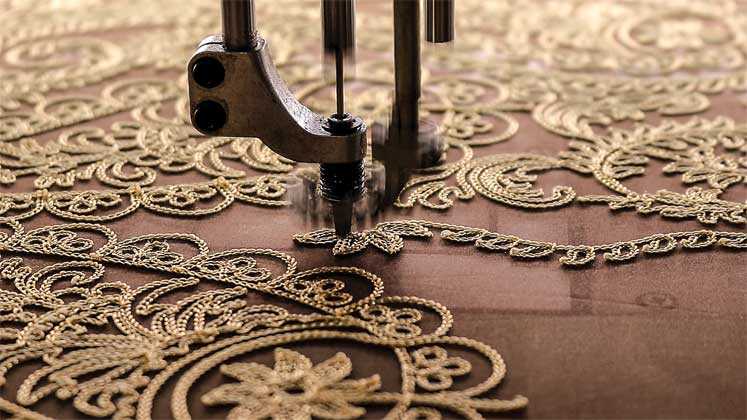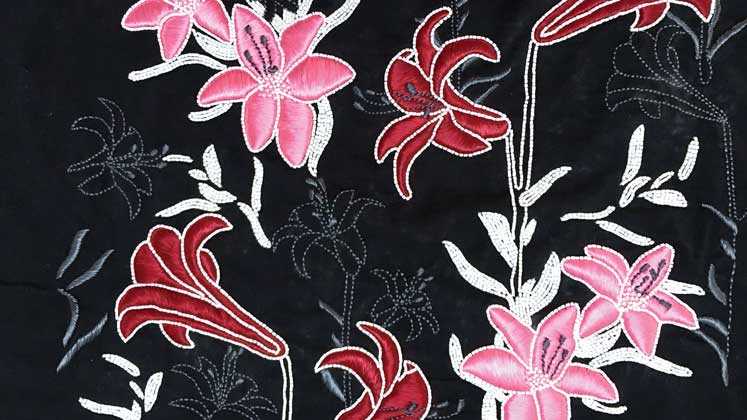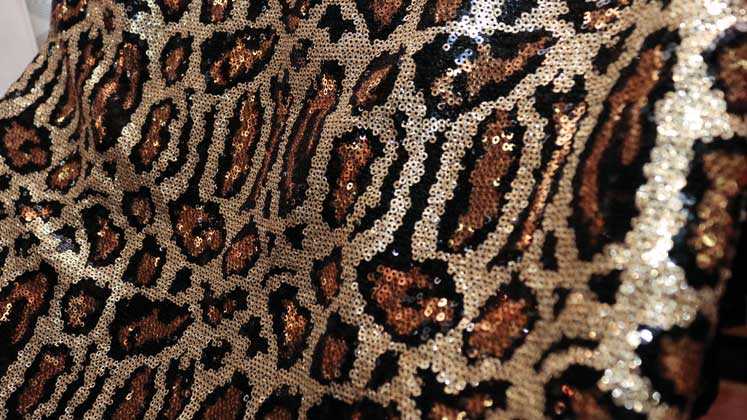
Embroidery, the segment that was once only known as the creative outlet of the ‘ideal homemaker’ has taken major strides to become one of the top export commodities of India, owing to its rich traditional heritage along with being one of the most distinctive Indian handicrafts. Balancing its rich history and intricacies are the technological advancements that have aided in transforming this segment from an exclusively high fashion, customisation-led segment to a value addition category that caters to the masses.
As per reports by IBISWorld, the past five years have seen a modest growth in the commercial embroidery industry, and it is expected to sustain the growth, as the revenue will increase at an annualised rate of 0.2 per cent to US $ 1.1 billion during the current period. The sector is extremely diverse when it comes to trims, threads and eventually, the end product. The technique offers a plethora of options to explore, as embroidery today is being done over multitude of silhouettes without any gender demarcations, by utilising threads that vary in widths, colour and finishes, adding trims that can grade from the smallest of beads to the biggest of patches. This diversified functionality commanded the comeback the category saw in 2017, and since then, it has been on a high ascent.
Adding to its commercial value, the demand for logo-ed and labelled articles employed in the service fields such as administrative and hospitality sectors have seen a dramatic rise, further increasing its accessibility. Buyers prefer embroidered goods over other surface ornamentations due to the high quality, value addition dimension that they add to the articles, giving the designs a statement finish while keeping the aesthetics understated. On the ostentatious end, decades of fashion have witnessed the luxurious touch of intricate stitches and embellishments that embroidery provides, as couture fashion has time and again incorporated this technique as art. From ethnic and occasionwear to formals and street casuals, embroidery has been a recurring stance from racks to runways especially in the form of heavy sequins, patches and applique.
India is one of the biggest sourcing hubs for embroidered goods, and has been a go-to for several designers and fashion houses when it comes to the segment. In fact, London-based emerging fashion designer, Mary Katrantzou, employed most intricate, embellished embroidered patterns and techniques for her recent runway collection, while established Belgian designer Dries van Noten has worked with embroiderers in Kolkata for decades. Mumbai tops the list of sourcing destinations as several recognisable names in the luxury space are on the lookout for Indian embroidery. Team Apparel Resources talks to several stakeholders of the segment to gauge the direction the embroidery sector is going to take for the upcoming Fall/Winter ’19 and Spring/Summer ’20 seasons.
The Continuation of Classics

Several manufacturers and retailers corroborated the fact that the print trends for the season direct the kind of embroideries that will prevail, as prints and embroideries are popularly being used in conjugation with each other. Florals and animal skin prints made a massive comeback for Spring and Fall 2019 runways, and the classic motif is also trending in the embroidery sector. Gurgaon based J. G. Brands caters to the US and Brazilian market in a big way, dealing with heavy embroidery styles with added beadwork and trims. Aahan Bhasin, Director, J.G. Brands , shares that the buyers are going back to the mainstream prints. He states, “Along with high value addition embroidery, we do cording and sequins embroidery as well, but the motifs are constantly changing. For upcoming seasons, we are mostly facing a demand for floral embroideries and the buyers are asking to incorporate animal skin and fauna into the embroidered motifs.” He further sheds light on the silhouettes for the S/S ’20 season saying, “We are currently working on a lot of kimonos, caftans, maxi dresses and jumpsuits as the demands are dictating us. Price points of such garments are already high, thus buyers can always command a better price with the value addition of embroidery.”

Shashank Jain, Process & Operations Manager, Milaaya International shares similar opinion for the seasonal trend report asserting, “For Fall/ Winter 2019, the trends that are going to be popular are animal prints in sequins, beads, thread work with oriental inspired artworks like cherry blossoms, cranes, dragons, Chinese waves. Another micro trend for Fall/ Winter 2019 is Macrame and Cord work. For S/S ’20, classic florals emphasised using different techniques like 3D fabrication, florals with sequins, floral in thread embroidery. Macrame will be continued from 2019 and will turn into a macro trend. Another popular trend is all over sequins with sequins in various qualities and textures.”
Sheer, Breezy & Light
As fabric trends for the upcoming season are inclining towards luxurious surface finishes, lightweight materials, embroidered goods are adapting the same. The Spring 2020 season entails flowy silhouettes including maxi dresses, cover-ups, shrugs, kimonos and shirt dresses that are elevated from drab to glam using embroidery done over light GSM fabrics such as chiffon, cotton blends and organza, georgette. Paisley and folk embroidery with heavy material threads are the top choice for such styles. Fabrics with mild surface lustre or easy drapeability such as silk chiffon, silk crepe de chine, silk organza, silk habotai are being embroidered using low-denier threads with smaller motifs such as leaves and ditsy florals.
MODI Embroideries is a young player in the market catering to niche hand-embroidery segment. Bopanna Im , the company’s General Manager – Business Operations , sheds light on the kind of heavy embellishments that are trending with light fabrics in the high fashion side of the segment explaining,“We excel in the niche category embroidery and our work is very versatile, as we can do small elements like brooches, 3D characters to big panel embroideries and from intricate florals to rustic raffia work at ease irrespective of fabrics or leather. Crochet and Macrame works created incorporating beads and some natural stones, manipulated fabrics in the form of braids and flower appliques, woven raffia, leather and chenille also give an edge to the garment along with embroideries.”
Sharing similar thoughts about sheer and minimal embroideries, Aahan states, “The consumers are now looking for embroidery that is visible yet soft to touch and easy to wear, which is in turn what the buyers are urging for. We are therefore making embroidered garments without any fabric or paper backing at all. Sometimes, the garment is solely made of threads embroidered together, held together with techniques such as knotting and crochet. Another instance of aesthetically minimal embroidery are techniques such as negative embroidery or jump stitch embroidery.”
Utility with Embroidery
The utility high rained on the runways like a thunderstorm as designers found their translation of functionality by mixing it with street silhouettes. This trickled down to several retailers to adapt the trend using silhouette modifications such as boxy fits, waist-belts and bellow pockets. The embroidery segment also experienced a boom when one of the biggest utility material, puffer, made a resurgence in a big way. Exporters established in the segment were quick to include quilting operations to the memo to match its demand, with contemporary surface design on light summer down jackets bidding well for the buyers.
Akshay Jain, Director of Ludhiana-based knitwear exporter, Top Gear Garments , recalls quilted garments having a good presence in the kidswear category for boys. “We included the embroidery operations to have a monopoly over the quality of embroidery we are imbibing in our garments. It also helps in cost-saving. We deal in the kidswear (boys) segment, where basic motifs such as monogram logos, patches with felt, etc., are majorly done on knit fabrics encompassing slubs, poly-acrylic, suede and Chinese cotton knits. But for jackets, we go for in-house quilting. Trending fabrics for this are nylon and polyester blends along with N.S. fabric, with main pattern in demand being diamond quilting. Other options are stripes and honeycomb structure quilting as well. Playing with stitch directions adds dimension and depth.”
Spotlighting the Thread
With so much focus on the tactile quality to be soft for embroidered garments, the aesthetics are to be highlighted to make the design stand out. Threads that are high on lustre, popping with colours or different in structure such as fringes and layers are high on the radar for buyers. Embroidery and embellishment industry expert Reiner Knochel vouches for viscose threads that play with light and shadow. “Some of the key words this season are transparency, shine, iridescent effects, layerings, fringes and natural looks. Opalescent and iridescent colours and effects seem to be one of the decoration highlights for the season, while layering the embroidery to create 3D effects and embroidered fringes to make embellishments eye-catching are also trending since Summer 2019,” he adds.
Bringing on the ’80s charm will be bold colours such as neons and shimmer threads, as contrasting black, silver, gold or flashy colours like bright pink or faded green will prevail for the season. As Aahan avers, “The biggest trend that can be seen is the use of fluorescent colours in embroidery such as neon green, pink and orange. Almost all of our customers have this demand. Apart from that, sharp contrasting threads with shiny elements, further elevated with trims such as chemical or cotton laces, beadwork, tassels (made of embroidery threads) are also in production.”
For top quality results, exporters are also using different thread sources for specified end products. Mamatha, MODI’s Creative Head talks about the thread preferences they practice saying, “We achieve excellence in versatility by varied thread usage. Gutterman threads are known for their long lasting functionality, so for all the major stitching, stone attachments and other materials, we use Guttermann. Gunold offers plenty of thread options for machine embroidery though all can be used in hand embroidery as well. They have unusual threads that give special effects post embroidery. Cotton thread widely known as Anchor Thread is also being extensively used along with some rayon threads while spun poly threads for general stitches are being sourced from Madura Coats.”
The constantly evolving machine embroidery trends and the equally expanding hand-embroidery techniques are balancing each other to create a gradually growing embroidered goods industry. Yet, several key players are showing concern over the ever present sustainable fashion demand that is now hampering sales. Shashank addresses the issue stating, “Fashion is considered to be one of the most polluting industries. While maintaining the age-old art and craft of embroideries, it is imperative to introduce innovation in terms of techniques, designs and materials, keeping them sustainable and compliant to environmental and social parameters. We, as a company, are striving to make the materials we use compliant besides also trying to minimise the wastage of fabrics and materials. There is a huge demand for recyclable embroidery materials to be used in surface ornamentation and it is our endeavour to provide these to our clients through timely research, sourcing and application of these materials and methods in our work while syncing with not just our buyers’ wishes but also that of the end consumers. “

Post a Comment